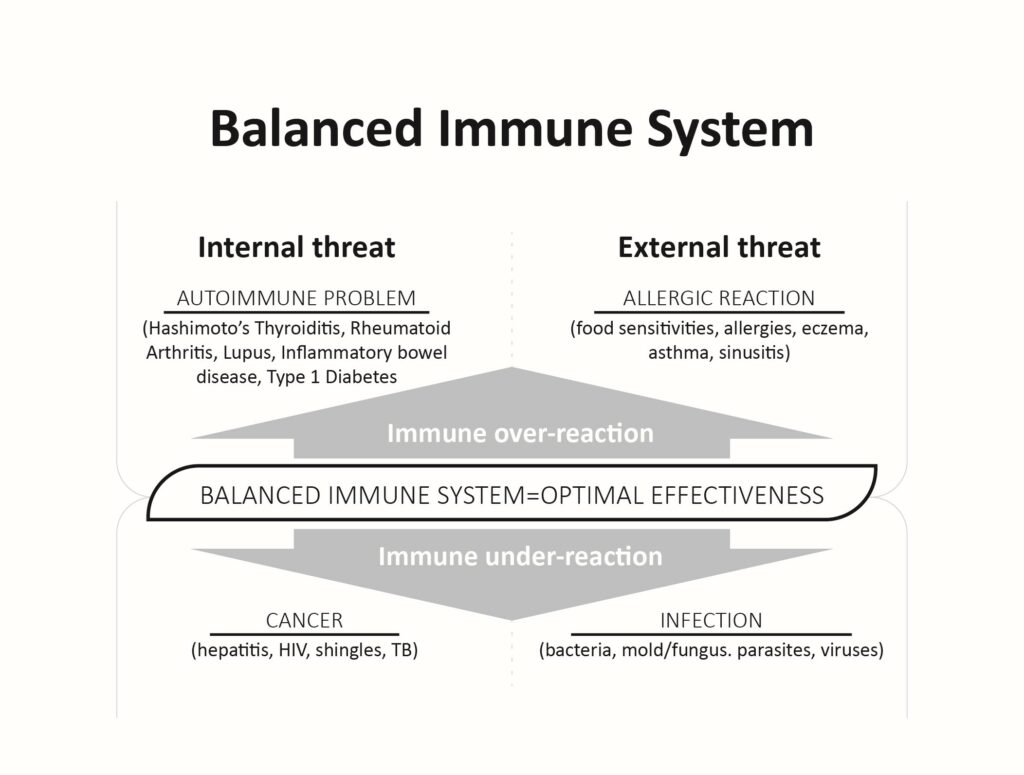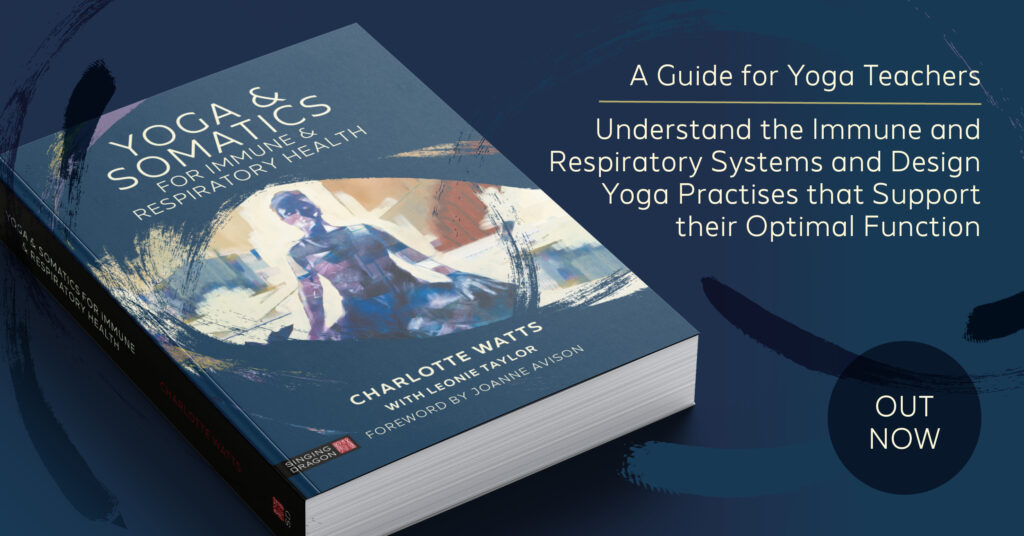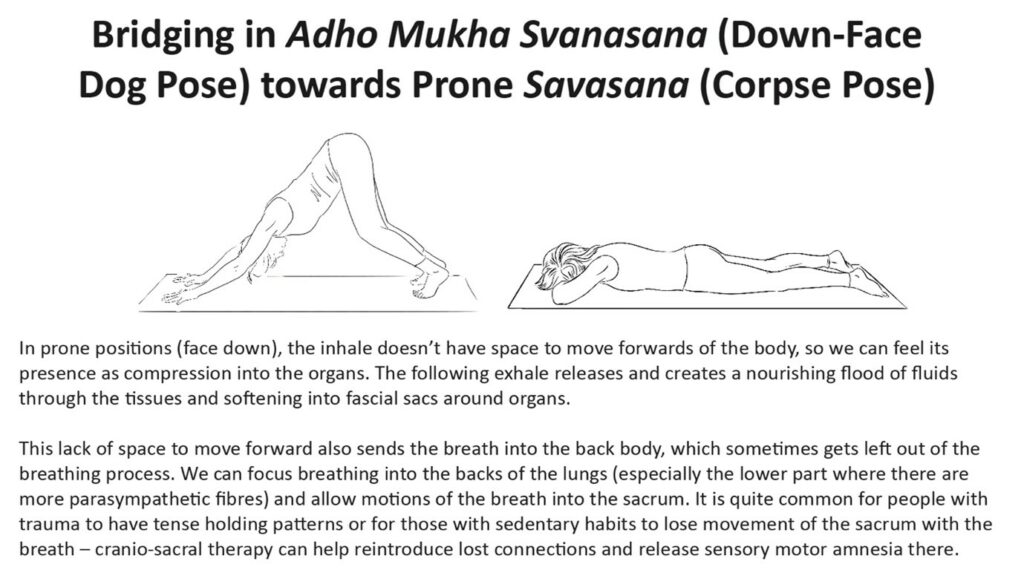In the dark, winter months, we explore how yoga and meditation can help refresh and support optimal immune function
By Leonie Taylor and Charlotte Watts, co-authors of Yoga & Somatics for Immune & Respiratory Health(which this article has excerpts from).
January is a common time for resolution-based diets and lifestyle shifts that may purport to ‘boost our immunity’. As we explore in Yoga & Somatics for Immune & Respiratory Health, ‘boosting’ immunity is, however, a problematic phrase, as immune issues are so often down to poor modulation – inappropriate rather than inadequate immune responses – with some parts stuck on over-reaction, especially inflammation. We can see in Fig 1, below, how the immune system’s balance can become dysregulated in either direction, leading to different issues.

Bacteria, mould, parasites and viruses are a normal and constant part of our internal landscape, and a healthy immune response will usually resolve any pathogenic invasion with some kind of short-term symptomology – cue the seasonal coughs and colds. But poor-quality nutrition, physical inactivity, psychological stress, trauma and circadian disruption can all lead to an over-vigilance of our immune responses, leading to classic inflammatory diseases so often seen in Western societies.
Dr Mark Hyman, states:
‘Modern immune systems face unprecedented challenges, like accumulated toxins in the environment, calorie-rich diets that provide little nutrition, and global sharing of microbes, to name just a few (Haahtela 2019). Repeated exposure to stressors like these can skew immune function, creating an imbalance between our immune systems’ core capabilities to play offense and defense. Over time, this can set the stage for inflammation, susceptibility to infection, hypersensitivities, and other signs of immune imbalance.’1

Immuno-rejuvenation
Dr Jeff Bland (founder of the Functional Medicine model2) calls the damage that accumulates in our immune system as we age ‘immuno-senescence’ – old, tired ‘zombie’ cells drag us down into dysfunction and disease. Its opposite is ‘immuno-rejuvenation’ – where instead of blindly boosting a damaged immune system (exaggerating defects), rejuvenation uses our built-in programming to rebalance and reboot the system’s optimal function – a more foundational and longer-lasting solution. Epigenetic factors – elements within our life experience that affect our gene expression (also including psycho-social stress and trauma) – are those we can affect and that are constantly influencing our immune cells. These turn over fast, so as Dr Hyman says, “we can essentially build an entirely new immune system every few months”, but the question is then: “would you rather recreate the old one, or build a better one?”
Boosting imbalanced or poorly trained immune cells will only amplify immune dysfunction. Immuno-rejuvenation on the other hand, is our bodies’ natural system of refreshing immune cells for optimal immune function. Rejuvenation only happens when you let it, when dropping stress hormones allows this growth potential:
- Eating well: fresh, balanced and nutrient-rich
- Staying active (that is, not sedentary)
- Supporting resilience with ‘good stress’ (eustress; healthy challenge)
- Getting adequate rest to optimise rejuvenation capacity – quality sleep and conscious relaxation (such as restorative yoga practices, meditation, mindfulness).
This is in line with the work of the Human Cell Atlas initiative3, whose mission is to create comprehensive reference maps of all human cells – the fundamental units of life – as a basis for both understanding human health and diagnosing, monitoring and treating disease.
Their studies of SARS-CoV-2 and COVID-194 included comparisons of asymptomatic COVID-19 patients with those with more serious reactions. In asymptomatic cases studied, they found increased levels of B cells (which produce antibodies) in mucus passages such as the nose, and helper T cells (that fight infection), which were absent in those expressing serious symptoms, many of whom had serious inflammation in the lungs. Patients with mild to moderate symptoms also had high levels of B cells.
Adding in an epidemic of mouth-breathing tendencies as a key epigenetic factor, as cited in an article titled ‘Lessons learned with long-COVID5’, focus on the breath regulation is now seen within many therapies as the key place to regulate the nervous system, activate that vagus nerve and alter ‘stress chemistry’. This is where yoga practices, including conscious breathing, can have profound effects on our body’s natural ability to defend itself.
Wisdom in motion: somatic practises to modulate immune response
The conscious movements that we explore in yoga and somatics, combined with awareness of the breath have many benefits which affect our immune system’s efficiency; from expanding our lung capacity, regulating our heartbeat and stimulating lymphatic flow.

- Explore Adho Mukha Svanasana (down face dog) with an attitude of restfulness, sliding the tailbone from side to side to release the core fascial sheath and either side of the spine.
- Come to prone Savasana (corpse pose), hands under the forehead, palms down. You may feel to roll gently side to side with the knees bent, feet raised, to really release the lower spine before settling.
- Tune into the breath radiating from the belly out into all parts of our body and being.

Breathing for immune regulation
“Belly breathing and Coherent Breathing… shift the nervous system response into a healthier balance by activating the healing, recharging part of the nervous system while quieting the defensive, energy-burning parts.”6
Coherent breathing aims to increase available diaphragmatic range and gaseous exchange, coordinate thoracic and heart pumps and restore parasympathetic tone of the nervous system. All of which helps the body rest and heal, reducing inflammatory response.
- Sit upright, comfortably, take a few easeful breaths.
- Breathe in and out fully a few times and notice the natural breathing pattern.
- Notice how long, smooth and steady the exhale is.
- Begin to count your exhalation, gradually lengthening to a count of six*.
- Repeat for a few rounds then relax, breathing naturally.
- Resume the count on the exhale, noticing any physical sensations.
- Add the count on the inhale, attentive to how it feels. If there is any strain, go back to counting the exhale only.
- After a few rounds, sit or lie in savasana and simply notice the breath and physical sensations.
*Adjust the count to be less if it feels forceful
1See more about the links between breath, mindful and fluid movement, embodiment and self-care, and support for our defences and health by Charlotte Watts and Leonie Taylor in Yoga & Somatics for Immune & Respiratory Health (Singing Dragon 2022).
1 Hyman 2021, https://drhyman.com/blog/2021/11/01/the-difference-between-rejuvenating-and-boosting-your-immune-system
2 https://jeffreybland.com/
3 www.humancellatlas.org/covid-19
4 Integrated Healthcare and Applied Nutrition magazine
5 Sehinson 2021
6 Brown & Gerbarg, The Healing Power of the Breath (2012)